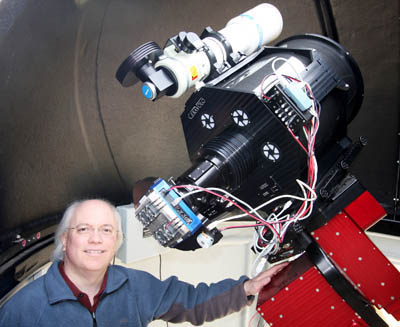A Customer's Testimonial

Doug George in his observatory with his Ceravolo 300 Astrograph
Subject: Re: [RASCAG] Re: Ceravolo Astrograph
From:“Douglas B. George” dg@cyanogen.com
Date: Wed, 25 Mar 2009 12:36:07 -0400
To: RASCAG@yahoogroups.com
Serge Theberge wrote:
> > Hi Doug,
> >
> > Nice images! Looks like you are getting great value from this scope. What
> > are your impressions so far in comparison to the RCOS you previously had?
Thanks to the unusually clear weather (I just broke the “new telescope clouds law”), I’ve already logged 13 nights and about 70 hours of exposure time. I’m well past “first impressions” already, and can give it a pretty thorough review.
Not to knock Brad and the guys at RCOS, who do make a fine instrument... I think the Ceravolo Astrograph blows it away.
Most importantly, the images are better. The RCOS had a lot of asymmetric scattered light and spikes on bright stars. The faint stars look exactly the same between the two instruments, but the bright stars are a *lot* cleaner on the Ceravolo. Also the stars are tack-sharp to the corners of the field (the Ritchey-Chretien is very good but still needs a field flattener, which I didn’t have; the Ceravolo has one built-in).
I like the thermal/focus management system better. It’s simpler; it doesn’t require an hours-long calibration procedure for the heater system to work. It works out of the box - no fiddle, in fact no adjustments. It also directly controls my Optec TCF-S3 focuser *without* the Optec controller box. And *both* mirrors come with thermally regulated heaters attached, not just the secondary. Here in Ottawa I really need both. It can also control a rotator motor, although I haven’t tried that yet.
The one thing that was a little better about the RCOS is that the fans would ramp up and down automatically; the Ceravolo just switches them on/off automatically. They’re a bit noisy. But that’s a nit.
The compact format of the Ceravolo Astrograph means it fits a *lot* better in my small-ish observatory. The RCOS would come within a couple of inches of the dome -- front AND back -- in several places. That was after adding a big counterweight hanging out the front of the saddle plate to force the telescope forwards; otherwise it would not have fit at all. And the most vulnerable component -- the focus motor on top of the spider -- was way out front skimming the dome. At first I was holding my breath whenever I moved the telescope. In comparison, I have plenty of breathing space with the Ceravolo.
It also appears to have superior mechanical stability. My MaxPoint models have lower residuals. On my run last night I got peak (not RMS) residuals of two arc-minutes. That means I can point anywhere and have the target very near the center of the field.
The RCOS was a truss telescope, which was very sexy, but in the real world it was a huge invitation to spiders, and it was difficult to properly cap the telescope (three caps required, and only one came with the telescope). While the Ceravolo comes with a front cap with locking thumbscrews, the RCOS required tools if you wanted to lock the main mirror cap down. And if you didn’t bolt it down, the cap would slide out of the instrument if you happened to point it downwards for maintenance. I always forgot and had to catch the cap on many occasions. Fortunately there’s a warning sound as it slides down the baffle.
And then there’s the collimation issue. This is a *huge* headache with Ritchey-Chretiens. It’s butt-simple with the Ceravolo Astograph. Just two screws! One moves the secondary tilt up/down, the other left/right. No farting around trying to decide which screw to use! No need to center the mirrors to a few thousandths of an inch! And the adjustment screws give you a nice fine motion, which gives you precision control. You can collimate it in a few minutes, instead of a few hours using specialized tools. (No, I’m not kidding about the hours or the tools -- a Takahashi collimation scope is mandatory for the RCOS, and if after using the thing you don’t have everything perfectly centered, then you have no idea what you did wrong or how to fix it.).
The Ceravolo Astrograph has less vignetting. Sure the secondary is huge but in operation I don’t see the difference... except for the less vignetting part.
Then you add in the bonus of being able to operate it at f/4.9 or f/9, which is rather cool. This gives you a lot more flexibility about which camera to use, and whether to shoot wide fields or close-ups.
So suffice it to say I’m quite happy about making the switch. The RCOS was a big step up from the C14, but I’m even happier with the Ceravolo Astrograph.
Doug George,
Author, MaxIm DL